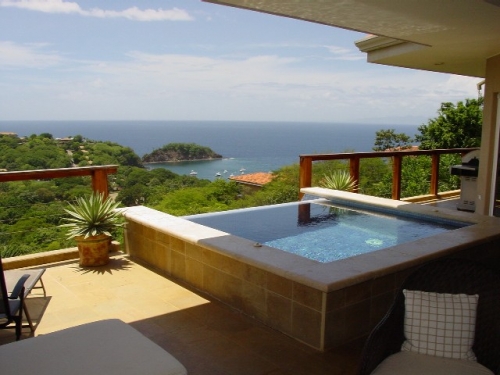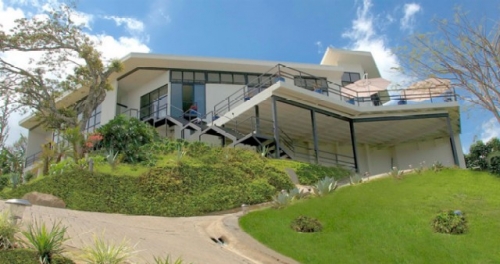Costa Rica Guide
Costa Rica Real Estate
List your property today!
Inclusion of real estate listings at Costa Rica Guide is
absolutely free of charge.
Featured Properties
Costa Rica Guide - Costa Rica Real Estate
South Pacific Region - Costa Rica Country Profile
Between mystical forests and splendid beaches, Costa Rica’s South Pacific offers the visitor a blend of ethnic influences and different microclimates.
Wherever you start your trip to Costa Rica’s South Pacific area, the journey guarantees an unforgettable experience, a combination of mystical forests with plenty of wildlife and idyllic white sandy beaches.
The South Pacific is characterized by a blend of ethnic influences and different microclimates. From the highlands of Chirripo and Cerro de la Muerte down to sea level, Costa Rica’s South Pacific features eye-catching scenery and a good network of roads connecting the entire area.
As a matter of fact, most of the country’s protected areas are located in this southern region. The recently paved coastal road running from Dominical and connecting further south with the Pan-American Highway assures visitors a superb ride.
Nine of the most important national parks and protected areas, and half of the nature reserves in the entire country, are located here. The incredible amount of biodiversity and number of microclimates contained in these territories are reason indeed to dare and visit them.
The coast is beautifully forested and lined with almost perfect beaches. Surfing, tanning, horseback riding and many other options are available, including elegant and rustic lodging services.
A gathering of species
There is practically no animal species in Costa Rica that can’t be found in the South Pacific. It’s common to see monkeys, coatimundis, peccaries, agoutis, armadillos, sloths, deer, squirrels and bats. Those are joined by iguanas, crocodiles and other lizards on the land and in the water. Magnificent hawks, ducks, toucans, flycatchers, parrots and macaws cross the air in colorful flight. Those who go deep into the forest find jungle cats, tapirs and quetzals.
Adventure is the key word along the Pacific Coast. You can enjoy scuba diving and snorkeling at Caño Island where the waters are clear and dolphins, whales, sharks and turtles are often spotted. You can paddle a kayak or simply sunbathe on the Golfo Dulce beaches. There is great variety of species in the sea for sportfishing enthusiasts.
Imagination is the only limit to enjoying the South Pacific region of Costa Rica. It is as if heaven has turned upside down. Pineapple plantations, rural villages and cities such as Perez Zeledon line up along the Pan-American Highway. Reaching down to the Panamanian border, they offer travelers a contrasting view with stunning colors and impressive accents.
Mirroring the country’s diversity
The lowlands are friendly and impressive, while high elevations such as Mount Chirripo-12,530 feet above sea level-give a completely different view of the country. This national park contains U-shaped glacial formations, moraines, terraces, lakes and creeks. It is the only place in Central America where you can find moorland vegetation as well as characteristic fauna. After a hard day on the heights, visitors find the relaxing calm of the hot natural spring waters of Herradura very welcome on a cool night.
There are two ways to enjoy Costa Rica’s southern region. On one hand there is the Pan-American Highway with the impressive and seductive villages and cities running alongside, full of tradition and friendly people. Presenting a final touch of civilization before going deep into the highlands, this is a place where wildlife prevails, nature rules and tradition sets the pace.
On the other hand, there is the coastal road with its contrasting scenery of long beaches, quiet bays and wild surfing sports.
In any case, don’t miss the chance to see stunning waterfalls such as Nauyaca on the way from Perez Zeledon to Dominical Beach.
The Osa Peninsula is an untouched region with unexpected panoramas of nature in the most pristine and primal state. It is also a land of hundreds of exotic beaches like Dominical and Dominicalito, ideal locations for camping, swimming, fishing and bird watching. This is one of the favorite spots in Costa Rica for professional surfers because of the great strong waves and the active nightlife in the towns.
Uvita is a small town south of Dominical. Tourists have barely discovered this amazing place. It is rich in marine life and coral reefs great for snorkeling or a quiet time on a palm-lined sandy beach. Also at Uvita is Isla Ballena (whale island) National Marine Park, a seasonal migration point for the Jorobada whale. About five kilometers offshore is Ballena Island, a whale shaped islet that supports the most exuberant vegetation and the spectacle of hundreds of marine birds flying around.
Legend says Sir Francis Drake buried his treasure somewhere along this coast near Drake Bay. This picturesque area, lying at the base of the Osa Peninsula, is an ideal spot for hiking in the jungle, fishing, swimming and surfing on powerful waves. Not far away is the Sierpe River, the entry point to the wetlands of the Sierpe Mangroves that cover about 36,950 acres. Offering fantastic possibilities for sport fishing, this area is also home to caimans, monkeys, crocodiles and rare species of birds.
Caño Island is a tropical paradise for lovers of aquatic sports like snorkeling and scuba diving. Its virgin beaches of white sand and crystal clear waters are perfect observation points for dolphin, turtles, sailfish and coral reefs. It also has an important archaeological significance as a pre-Columbian cemetery.
At the mouth of the Sierpe River is Violin Island. This is a valuable archaeological site with a great variety of vegetation. Hermosa Beach and Bahía Beach have the best conditions for swimming, snorkeling, diving and fishing within about 11 kilometers of complete, natural conservation. Following north along the shore are Ballena Beach with its fine, dark sands, the intimate and exuberant Piñuela Beach, and the beautiful Ventanas Beach, a great spot for those longing to rest under coconut palms and enjoy the blessings of the rain forest.
Large protected areas
Within an area of 3,234 acres, the Golfito National Wildlife Refuge is meant to protect a primary evergreen forest where more than 125 species of trees have been identified, thus also preserving the watershed for the population of the region. Golfo Dulce is the home of an incredible variety of wildlife and birds, and is also a great spot for sportfishing. Golfo Dulce Forest Reserve has an area of 172,973 acres of dense evergreen forest of precious woods and features various other attractions such as Chocuaco Lagoon.
Piedras Blancas National Park, deep in the rain forest, is one of the main projects of Esquinas Rainforest Lodge. This is a perfect place for bird watching and getting in touch with nature. For those who want tranquil, clear beaches near Golfito, try Gallardo, Cacao, Puntarenitas and Atrocho Beaches. Further South is Zancudo with fine, gray sands and abundant vegetation. The estuary is navigable in small boats; restaurants and lodging are available. Best known among surfers as the place with the "longest left hand break," Pavones Beach is a semi-open bay featuring great waves all year long. Pavones is now a surf town in the middle of an exuberant rain forest, inhabited by fun and friendly people.
Acting as gateway to Corcovado National Park, visitors from every part of the world have gone through Puerto Jimenez and some of them have decided to stay. This is a multi-cultural town with all facilities of transportation, beaches, clear waters and great places to eat. Puerto Jimenez is a well-developed town with a great number of tourist attractions. It’s also a spot for the traditional extraction of gold by hand: women, children and men intern themselves in the woods looking in the streams for little treasures.
Corcovado is a 134,768-acre area of humid rain forest and 5,930 acres of ocean protected by the Costa Rican government. It’s also one of the most famous areas of biological diversity and conservation in the world. The park is dedicated to the protection of the endangered animal, while various plant species are currently under investigation as possibilities for the next medical discovery.
The above information is courtesy of Costa Rica Institute of Tourism (ICT).






